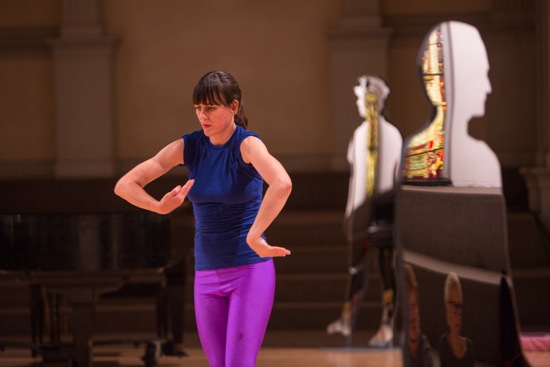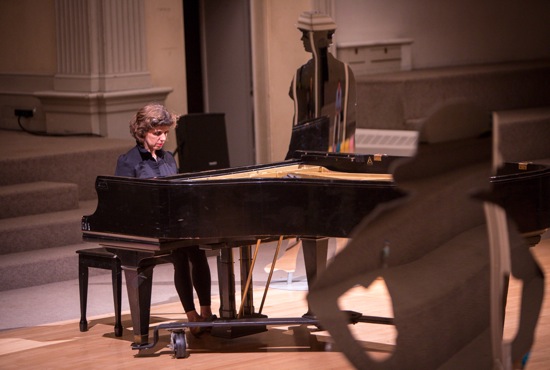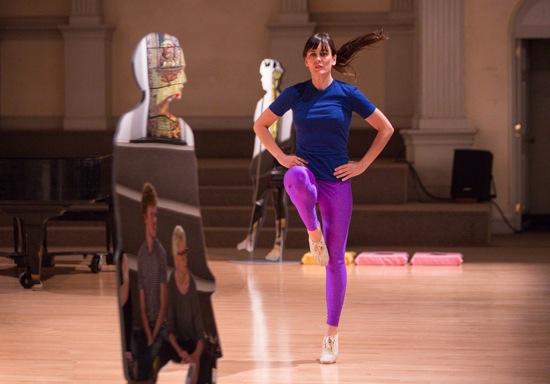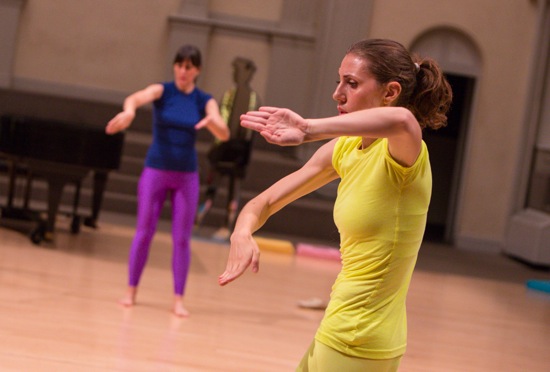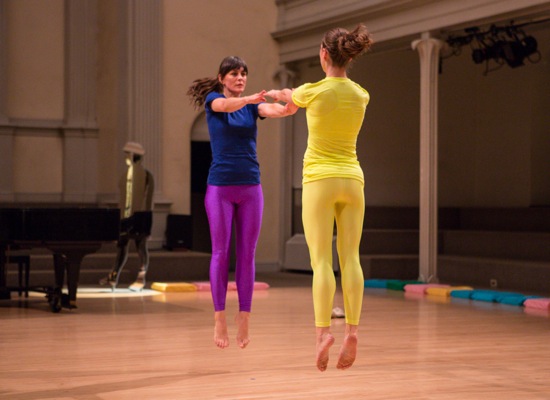DD Dorvillier adds a new work to her month-long reassessment of her history in dance.
DD Dorvillier always seems, in her choreographic projects, to be testing something. Perhaps it’s the audience’s perception of dance, or her own. She probes into the interactions of light and darkness, into the effect of space on sound vibrations, into the interference of objects on live dancers, and more. Translation between languages interests her. So does borrowing structures from other art forms and re-envisioning them. I can think of few choreographers who could fill so inventively a month-long “platform” like the one that DD Dorvillier/human future dance corps and Danspace Project presented this June at St. Mark’s Church and at other sites around town. Danspace Project’s executive director, Judy Hussie-Taylor, needs to be lauded for her vision.
Dorvillier has made it clear that her Diary of an Image is not a retrospective. That is, none of the dances that she has made since 1990 are being revived and presented in their entirety. She thought about the process, she said in an interview, “as cracking a whip in the air and seeing the pieces that fall in the moment.” I didn’t see the performances that she included by other artists whose work had an impact on hers (among them Jennifer Lacy and Jennifer Monson). I have read Diary of an Image, the book with commissioned texts that can be purchased at the performances. And I have seen one component of the series, A Catalogue of Steps—or at, least, a particular version of it at one of the free afternoon performances—and written about it (https://www.artsjournal.com/dancebeat/2014/05/please-do-it-again/). For this, three dancers (Nibia Pastrana Santiago, Katerina Andreou, and Oren Barnoy) learned fragments drawn from Dorvillier’s previous works and performed them, re-situated and without their original accouterments.
A new dance, also called Diary of an Image, mingles Dorvillier’s history and the present moment in extraordinary and enigmatic ways. Three silhouetted figures with mirrored surfaces stand in various spots. Created by Olivier Vadrot, who also made the gorgeous flags (each representing a Dorvillier dance) that hang overhead. The figures represent, the program tells us, Lacey, Monson, and Sarah Michelson (also influential on Dorvillier’s thinking), but they also reflect the immediate atmosphere of the church: images of the audience, seated on cushions that surround three sides of the area, slip onto one simulacrum’s leg; another mirrored honoree wears a lopsided crown made of reflected parts of the moldings around the balcony.
Composer-performer Zeena Parkins walks briskly across the floor and seats herself at a lidless grand piano. We wait for her to touch the keys. She doesn’t. Just sits there with her hands in her lap, surveying the space or (apparently) meditating. A gentle mid-range hum begins to filter into the space. Other tones filter in and out subtly; you don’t know they’ve disappeared until they have. Electronic equipment up on the balcony, you suppose. But there’s something eerily present about the sounds and their relation to the apparently motionless pianist. (later, I learn that eight battery-powered, magnetic “ebows” have been placed on certain groups of the piano’s strings, and that Parkinson’s foot on the instrument’s sustain pedal is causing the strings to vibrate and resonate in collaboration with the church’s architecture).
Even stranger sonic devices and the placement of speakers hung around the perimeter enable the mirrored cut-outs—spot-lit by lighting designer Thomas Dunn—to converse. You could swear the voices are emanating from them. The give-and-take isn’t comprehensible, at least, not at first. The first voice chants rhythmic variations on the vocal sounds “dee” and “da.” The second voice uses the same vocabulary (all the voices were recorded by Dorvillier and the repeated “dee”s invoke her name, as well as the sound of Morse code messages being sent). Sometimes, the voices mingle in a fuzzy unison that bounces off the wall (and maybe us). Other sounds enter: “em,” for instance. “You-you” becomes “I-I-I.” By the end, two or three short sentences emerge. Always the voices are calm, angelically resonant. Then Parkins stands up and runs out the door, and Dorvillier enters. I don’t know at what point I realize that the church’s stained glass windows are brilliantly illuminated by Dunn’s lighting. Now we have other watchful presences, some of them saintly. Passersby on Second Avenue or Tenth Street will see a glowing church.
The four doors leading to other parts of St. Mark’s are open, and at some points during Diary of an Image, the spaces behind them are lit. Once, beams of light that make you think of heavenly radiance in Renaissance paintings streak along the floor from the central front door.
All the preceding has taken some time, but that’s fine. You seem to have been enveloped in a giant “om”—a Methodist church awakening to Buddhism. So now here’s Dorvillier wearing shiny purple tights and a navy-blue tee shirt, and she is dancing. Her springy little step-hops don’t cover a lot of space with each repetition, but they take her around the floor in various patterns. Erect, and holding her hands on her hips or occasionally opening her arms wide, she brings to mind a grave celebrant in certain folk dances—Balkan, maybe (she has experienced those). Every once in a while, she’ll jump two or three times straight up, followed by one jump bending to the right with her arms slashing in that direction. Occasionally she pauses, standing on tiptoe and reaching forward, as if to stabilize herself and take a few deep breaths.
As with any minimal dancing rooted in repetition, you watch for variations. Some are clear—a heel-and-toe action, a lift of the knee following by thrust-forward foot; others are even subtler—shifts in Dorvillier’s breathing, her gaze, the bounce of her ponytail. She travels backward, then forward. She sees the church and the three figures she passes. Her rhythm is plain and unvarying.
Suddenly, a big change. She pushes up the sleeves of her shirt, and her arms become a major player, her feet reduced to simple walking and turning. Sometimes one of her shoulders, sometimes an elbow, sometimes a hand leads her arms into smooth, serpentine motions; her fingers remain straight and clumped together as she carves the air. Later, I read that the first dance form Dorvillier learned was hula.
The speakers begin emitting low-key music with a drone involved, and another woman enters. It’s Andreou, wearing a chartreuse shirt and tights, and she launches herself into the step-hop dancing that Dorvillier has burned into our brains, with a few variations of her own. Dorvillier herself, having walked out a rear door, reappears through the front one, and dances her way out into the city again. This is the part when Dunn illuminates the various passages to other parts of the church or to the world outside, yet at this point, Andreou is moving unenhanced by lighting.
Parkins re-enters to make the strange instrument that the piano has become begin its mysterious choir of sounds, and the two women dance simultaneously, but rarely in unison. They work their arms. They do the hopping dance. It’s only now that I begin to see Diary of an Image as a ritual of sorts. These women are dancing to make something happen, except that we don’t know what that something is. I feel as if I’ve stumbled into a society whose customs are unfamiliar to me.
Changes do occur in the atmosphere. Parkins leaves again, and electronic sounds begin—at first sounding almost like rain; later they crash and clack dangerously and include what could be nasal voices. Pools of light appear around the mirrored figures, and Dunn makes the church as bright as noon. The two dancers’ shadows are thrown on the walls.
Dorvillier and Andreou rarely move in unison, but their patterns seem related, as well as more intricate. They look less like people proceeding along narrow, fairly straight trails, and more like travelers along the kind of roads that snake around. So their dancing appears to be more fully three-dimensional, even though the steps are the same ones we’ve been watching for a long time.
Another gradual change enhances the feeling of a ritual. The crispness of Andreou’s dancing never wanes, but she pauses quite often. Dorvillier visibly tires and attacks the steps less energetically than before. Yet there’s no question that the two will continue until they finish whatever they set out to accomplish. Or that they are ministering to a space that exists beyond the area that has been re-designed by their dancing, Parkins’s music, and Dunn’s lights.
Suddenly Dorvillier and Andreou pause facing each other and jump, both stretching their arms forward. They’re close enough to touch fingertips. Has a circuit been completed? I imagine lights flashing. But no. Side by side, they walk out the door that leads to the street. It takes quite a few silent moments for us to realize that Diary of an Image has ended and that we can clap now.

